© Copyright GRANMA INTERNATIONAL
DIGITAL EDITION. La Havana. Cuba
Total or partial reproduction of the articles in this Website is autorized,
as long as the source of the copyright,
THE REBEL ARMY'S WESTWARDMARCH
This time we did it
• In
July-August 1958, two rebel columns moved out from the Sierra Maestra with the objective
of taking the war to western Cuba, as the Cuban independence forces had done against the
Spanish empire in 1895 • Leading them were audacious guerrilla commanders Camilo Cienfuegos and
Ernesto Che Guevara, who on this occasion, through epic battles, were able to prevent the
United States from snatching away the people's victory
BY ALDO MADRUGA (Granma
International staff writer)
DESPERATE but unable to abandon
the Presidential Palace's comforts, dictator Fulgencio Batista gave the order from Havana.
Some 10,000 well-armed soldiers, with the support of armored cars and planes, conducted an
all-out attack on strongholds controlled by the rebel forces, headed by Fidel Castro, in
the eastern mountains. That was in late May 1958.
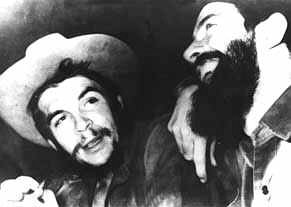
Camilo and Che, masters of guerrilla
warfare, were the commanders of the
two columns sent westward by Fidel. |
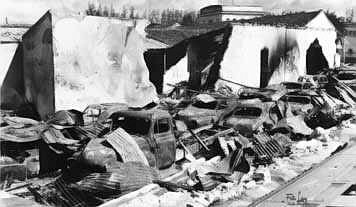
Government planes bombed Santa Clara
indiscriminately, trying to guess where the
supposed rebel hideouts were. |
By that time, members of Batista's military had begun
to call the dictator a coward because he hadn't visited the theaters of war or even
ventured near Santiago de Cuba, the second largest city in the country and then the
capital of vast eastern region.
After two months of confrontations, Batista's offensive
failed miserably. About 1000 of the regime's soldiers were killed, suffered injuries, were
taken prisoner or deserted. The government troops also lost a large number of weapons and
ammunition.
The guerrillas widened their zone of operations
considerably. Batista's captains no longer dared entered the mountains and the
revolutionaries didn't have enough forces to extend themselves to the lowlands. A sort of
"armed peace", as Comandante Che Guevara termed it, was spontaneously
established between the warring parties.
UNREST AMONG THE POWERFUL
Meanwhile, the owners of sugar mills, large landowners,
bankers and even the clergy were unhappy with the man who was running the country, despite
the fact that they had been his faithful allies or silent accomplices. The Cuban
aristocracy looked toward the United States with frightened, imploring eyes, since that
country had always provided the recipes for salvation, and even the exact ingredients for
its preparation.
On various pretexts, alleged journalists and other
envoys began going into the Sierra Maestra, Cuba's highest mountain range, about 1000
kilometers from Havana and the heart of the rebel movement.
In many cases their true purpose was to see if Fidel
Castro was really an implacable radical, or whether he would sell out to the United
States. At that point, the idea of replacing Batista with another faithful straw man and
keeping the regime's repressive structure intact was a subject of discussion among circles
within the United States.
For its part, in August 1958 the Rebel Army had its
position well consolidated, from a political as well as a military point of view. Unity
with other forces opposed to the dictatorship was stronger than ever and popular support
for the Revolution was growing, as more and more people joined the struggle.
All of the tricks utilized in an attempt to distort the
revolutionary process and prevent its victory - even though that possibility was becoming
stronger every day - were discovered and denounced by Fidel at the opportune moment. The
leadership of the Rebel Army was convinced that it was possible to broaden and intensify
the guerrilla struggle in the eastern mountains and also to take that struggle into the
center and western portions of the country, as the patriots fighting against Spanish
colonialism did in the 1895 war.
A WESTWARD MARCH TO ENSURE VICTORY
Thus, Fidel decided to accelerate the destruction of
the regime's repressive apparatus through a war of attrition and strangulation. The
immediate next step in that effort was to approach the main cities which served as the
enemy's bastion.
To that end, two rebel columns were formed, composed of
fighters who had proven themselves in battle. Chosen to head them were two of the most
skillful, militant and intelligent guerrilla commanders, who had gained their experience
under Fidel's direct leadership: Camilo Cienfuegos and Ernesto Guevara.
The Antonio Maceo Column No. 2, commanded by Camilo
Cienfuegos and named after the general who took the war against Spanish colonialism to
western Cuba in 1895, was given the order to leave the Sierra Maestra and move across the
island, fighting the enemy and arriving in Pinar del Río, the westernmost Cuban province,
then founding a guerrilla front there. That was the fundamental objective of that force,
the one to which all other tactical questions were to be subordinated.
Camilo was also given the task of organizing armed
units in all the territories through which he passed, as well as applying the Rebel Army's
penal code and putting its agrarian laws into practice.
The other column, led by Che and known as Ciro Redondo
Column No. 8, in honor of the brave rebel leader who had died in combat, was given the
mission of marching to the center of the country and ruthlessly fighting the enemy and
intercepting its eastward movements, completely paralyzing them, as well as other tasks.
Santa Clara, the capital of that region with 150,000 inhabitants, constituted an important
communications hub, in regard to railroads and highways, and served as the base for a
powerful military force.
Che was also designated as the head of all the units in
that territory of the 26th of July Movement, the organization led by Fidel which
protagonized the armed struggle against the pro-U.S. Batista government. Che was given the
authority to coordinate operations and plans, and to make pacts with other revolutionary
groups operating in the area.
The westward march's principal strategic elements could
be synthesized into the following objectives: Fidel, Raúl and Juan Almeida, the leaders
of the first, second and third fronts, would approach and occupy Santiago de Cuba; Camilo
would exert pressure on Havana from Pinar del Río; and Che would march to Havana, after
taking control of the country's central region.
UNSTOPPABLE, DESPITE...
By the month of September, both columns were advancing
on their objectives through the former province of Camagüey. It was impossible to conceal
their advance from the enemy. Various confrontations took place. There were campesinos who
informed on the rebel troops, some of whom were caught in some ambushes while others
escaped. They sustained their first casualties. About 1000 government soldiers
participated directly in actions to halt the rebel forces, composed of about 200 men who
were hungry and tired but fought fiercely.
Despite obvious signs of weakening, at that time the
dictatorship had over 20,000 soldiers with modern weapons, including tanks and planes,
plus concrete support from the United States. Indeed, despite its timid reproaches of the
dictator - more for being inefficient than for being corrupt - the United States provided
constant backing, even from its powerful intelligence services, the CIA and the FBI.
For that reason, Che arrived in the Escambray
mountains, in central Cuba, southeast of the former province of Las Villas, with troops
that had been beaten down by the superhuman physical effort they had made, poor nutrition
and tensions, but with a great fighting spirit. Camilo had been in the northern part of
that territory for the past two weeks, in the proximity of Yaguajay, an important
government military installation in the region.
They had left behind 600 kilometers of dangers, death
and sacrifice. According to Che, becoming accustomed to the hardships of guerrilla life
and risking their necks every day was a basic requirement for overcoming the obstacles
they encountered in that march. Another one was the fact that they brought with them an
agrarian policy which sparked unanimous interest among the campesinos.
Camilo and Che were welcomed joyfully by the residents
of the areas where they arrived, as well as by the majority of the insurgents operating
there. Meanwhile, the Popular Socialist Party united with Camilo, and Che received the
support of the Revolutionary Directorate, which sent troops and signed the Pedredo Pact,
as a result of which they fought jointly. But they also faced hostility and threats on the
part of a group called the Second Escambray Front.
Both leaders carried out a veritable political
offensive to achieve unity of action against the dictatorship, without encountering any
great obstacles. In practice, they also promoted the Revolution's lofty objectives for
improving the people's lives.
ALL-OUT WAR IN CENTRAL CUBA
In the second half of December, Che Guevara came out of
the Escambray mountains with several detachments, among them the Directory's troops, to
attack the town of Fomento, with about 10,000 inhabitants. After two days of bitter
combat, they occupied the town and took 141 soldiers prisoner, confiscating a large number
of weapons, ammunition and vehicles. After that, they attacked and occupied Sancti
Spíritus, Cabaiguán and Placetas, just 31 kilometers from Santa Clara. On December 25
they took Caibarién and Remedios; on the 26th they took Camajuaní and on the 28th some
300 rebels began the siege of Santa Clara, the region's capital.
Meanwhile, Camilo received Fidel's order to wait for
the consolidation of Che's front before continuing on to Pinar del Río. While remaining
in the area, his column made constant raids against the enemy, blowing up bridges,
attacking economic objectives, organizing militia units among the campesinos and taking
over army positions nearby Yaguajay.
Thus, the towns of Venega, Mayajigua, Zulueta,
Carrillo, Meneses, Iguara and others fell to the rebels. On December 25 they began to
attack Yaguajay. As the soldiers lost their positions in the city, they concentrated more
and more on the military installation there, which was subjected to a violent attack.
Fierce battles continued until December 31, when the men under siege, facing a desperate
situation, raised the white flag and surrendered.
In the northern and central western portion of the
territory, Batista's army abandoned its minor posts and concentrated on Santo Domingo and
La Esperanza, 50 kilometers and 16 kilometers, respectively, from Santa Clara.
Thus the historic battle of Santa Clara began. The
fighting was hard. The city filled with explosions. Over 3000 guards entrenched in
strategic positions defended it with armored cars and air support. The population, which
came out en masse in support of the rebels, practically decided the battle.
Little by little, the dictatorship's main bastions
fell. On the morning of December 31, only the Leoncio Vidal regiment was still fighting -
but Batista was fleeing and the military installation gave up its useless resistance.
Cuba's aristocracy and powerful looked with frightened
eyes to the north, hoping for the recipe for salvation. A coup d'état was attempted, in
order to intervene in the Revolution, but it didn't work. Fidel and Raúl took Santiago de
Cuba. This time the feat of the westward march would not be frustrated, as it was in 1895.
The repressive apparatus forged by the United States over 60 years was torn to shreds. Che
and Camilo received the order to march on Havana. The Revolution moved forward.
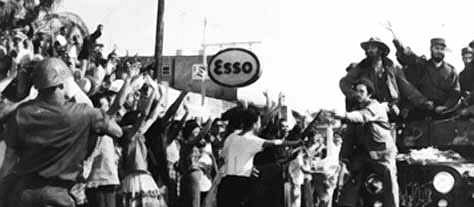
Fidel enters Havana on January 8, 1959, in the
culmination of the last rebel offensive
and following the taking of Santiago de Cuba by Fidel and Raúl on January 1.
|
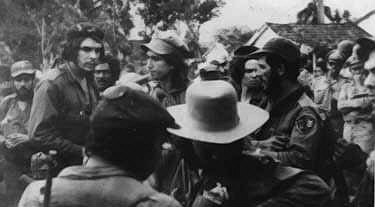
Che after the taking of Santa Clara.
|
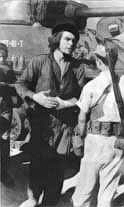
Comandante Guevara
after the taking of one
of Batista's garrisons. |

Camilo and other fighters in his column after the
taking
of the town of Iguaro. |
|